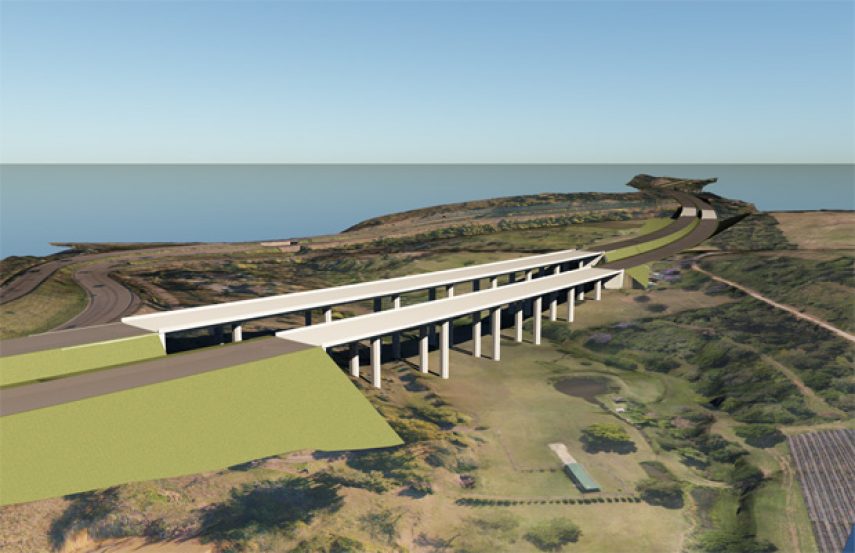THE N3 Corridor has got off the starting blocks: the 84km freeway between Durban and Pietermaritzburg – KwaZulu-Natal’s Gateway to Africa – is planned to be upgraded in phases over the next 8 to 10 years.
Phase 1 which includes the critical sections between Cato Ridge and Pietermaritzburg, the Key Ridge realignment and the EB Cloete to Paradise Valley section will be upgraded over the next five years by 2023.
Detailed designs are being drawn up for the reconstruction of the N3 between Durban and Cedara at an estimated cost of between R22 and R24 billion. The plans include a ring road around Pietermaritzburg to avoid the notorious Town Hill section of the N3.
This was announced by South African National Roads Agency SOC Limited (SANRAL) at a briefing to stakeholders aimed at showcasing SANRAL’s current and activities in KZN. A total of 1344km of roads falls under SANRAL’s purview in KZN of which 396km is tolled.
SANRAL Eastern Region design and construction manager Ravi Ronny said the N3 Corridor is essential if one of government’s strategic integrated projects linking the Port of Durban with Gauteng, South Africa’s economic heartland, is to succeed.
He said the SANRAL Board has directed that the project must be given priority and construction on the critical sections must commence within the next two years.
There are various work packages along the corridor with each package taking between 36 to 42 months to complete.
“Environmental impact assessments are also being commissioned while routes are being plotted to increase the capacity and safety of the freeway which will have up to four and even five lanes in each direction over certain sections,” said Ronny.
Major realignment of the highway will take place at Key Ridge and Town Hill where the steep grades cause major traffic congestion, especially when heavy-duty vehicles are on the road.
If the upgrades do not go ahead, it is estimated that users of the N3 will continue to suffer losses of nearly R800 million per annum – due to accidents and time delays. R775 million can be attributed to time delays and between R250 000 and R295 000 per hour to accidents and road closures due to accidents.
Currently the maintenance of the existing road at Town Hill is quite challenging and there have been incidents of crashes as traffic moved through the work zones. The expansion of the roadway in the current alignment is not an option due to the close proximity of residential and commercial properties and the extended period over which lane or road closures would be required.
Twelve proposed new routes are being investigated to eliminate the problems at Town Hill. A 14 km ring road around Pietermaritzburg and north-east of the current N3 alignment is being considered as one of the more favoured routes.
Ronny said the N3 carries in excess of 40 000 vehicles per day around Pietermaritzburg and consists of a mix of urban commuter traffic, long distance traffic and substantial heavy vehicles, with some sections in excess of 25% heavy vehicles.
“In excess of 40 million tons of freight per annum are carried on the N3 corridor, with approximately 9 000 heavy vehicles using the national road per day.
“Durban is by far South Africa’s busiest port with over 80% of goods moving along this corridor by road.
“Therefore, the need to consider the best economic solutions to ensure the seamless flow of freight is very important to this corridor,” said Ronny, adding any blockage on the N3 causing its closure was tantamount to a national crisis.
It was also announced that the roads network in KwaZulu-Natal is undergoing major refurbishment and expansion, with the rewards being safer motoring, time-saving, improved business links, better-connected towns and cities, jobs creation, empowerment, poverty alleviation and unlocking land for new homes and businesses.
A new interchange at Kwabhoboza has been completed at a cost of R242 million and will improve the safety of pedestrians and motorists.
Extensive overloading of trucks has resulted in a marked deterioration in the condition of the province’s road network. Thus, overload control is vital. The newly-opened traffic control centre at Eteza will curb overloading on the N2 north, thereby extending the life of the pavement and improving safety.
The major upgrade to the iconic Mt Edgecombe interchange at a cost of R1,1 billion is fast nearing completion within weeks, with some ramps already opened much to the glee of once frustrated motorists who had to contend with severe congestion.
Construction work for the upgrade of National Route N2 between the Mtunzini Toll plaza and the Empangeni interchange is under way. This R950 million construction project will see this 34km single carriageway road upgraded to a four-lane dual carriageway freeway.
Another project aimed at reducing accidents and improving road safety in KZN is the elimination of curves at Umhlali River Bridge and Umvoti River Bridge on the N2 North.
In order to fast track construction of a major interchange on the N3 at Hammarsdale between Durban and Pietermaritzburg, SANRAL entered into a partnership with eThekwini Municipality to share the R276 million cost of the project.
The upgrading of a 24-kilometre section of the R61 from Mbizana River just south of Shelley Beach to the Mtamvuna River at the border between KZN and Eastern Cape near the Wild Coast Sun casino complex, at a cost of R2,5 billion will see this reconstructed road becoming the new N2.
The new N2 on the KZN side will join with the N2 Wild Coast Highway currently under construction in the Eastern Cape. Once completed, the highway will be approximately 85km shorter than the current N2 alignment from Mthatha to Port Shepstone and will reduce travel time by about three hours.
There are scores of other projects in KZN running into tens of millions of rands involving periodic maintenance on various stretches of the province’s roads.

